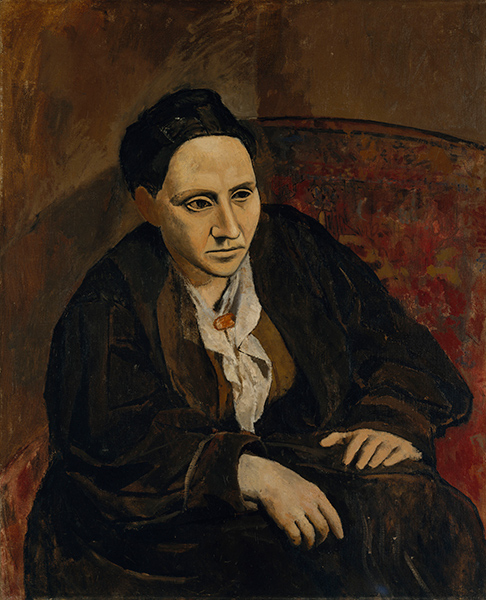Gertrude Stein and the pragmatism of William James
During the cubist period, Picasso’s close relationship with Max Jacob provided him with a space for shared reflection. Likewise, his strong friendship with Gertrude Stein enabled his production to draw upon her ideas–as her writing, in turn, drew upon his art. By having her companion Alice Toklas speak in the first person, Stein made no attempt to conceal her great ambition: to become the “Picasso of literature” someday. In her memoir published in 1933, provocatively titled The Autobiography of Alice B. Toklas, Stein evoked the explorations she carried out alongside her painter friend. The many sittings required for her portrait (1905-1906) were also opportunities for “endless conversation.”[1] Talking about the paintings that she produced leaning of two low chairs, “knee to knee”, Gertrude Stein told Picasso about her literary techniques, and the painter did not hesitate to suggest: “tell me about them.”[2] The result of a long training process, these writing techniques were informed by the teachings of William James. In this context, it is important to consider their implications for Picasso's art.
Beginning in 1905, the assimilation of Bergson's philosophy with the pragmatism of William James became a widely-known phenomenon. Often considered compatible with the literary output arising from symbolism and futurism, this combination of two ways of thinking is also viewed as having paved the way for the writing of the woman who would be referred to as the “Mother of Modernism”: Gertrude Stein. The concept of a stream of consciousness, or the resulting Bergsonian notion of duration, were at the core of her literary production to such a degree that they can be considered, with all the more reason, as integral parts of the creative process.
Before moving to Paris, Gertrude Stein had been a devoted follower of William James' classes at Radcliffe College. She studied automatic writing with him, which stirred up her urge to learn and further her knowledge of neuroanatomy in a laboratory at Johns Hopkins School of Medicine. Fascinated by the profoundly original thought and the intelligent observations of his student–who attempted to dispute the theories of social physics and the determinism of her era–William James recommended Stein to his former student Hugo Münsterberg, encouraging him to admit her into the laboratory research seminars he was directing at Harvard.





 Summary
Summary